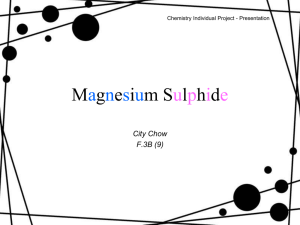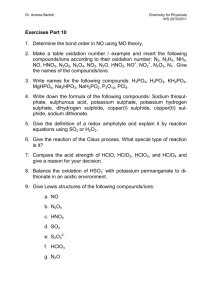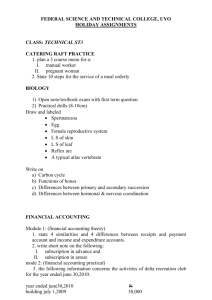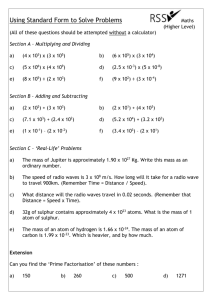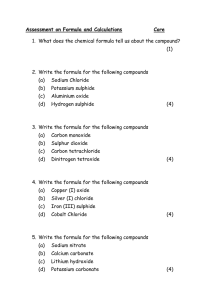ON As. 8.1 INFLUENCE OF THE SULPHUR ATOM
advertisement
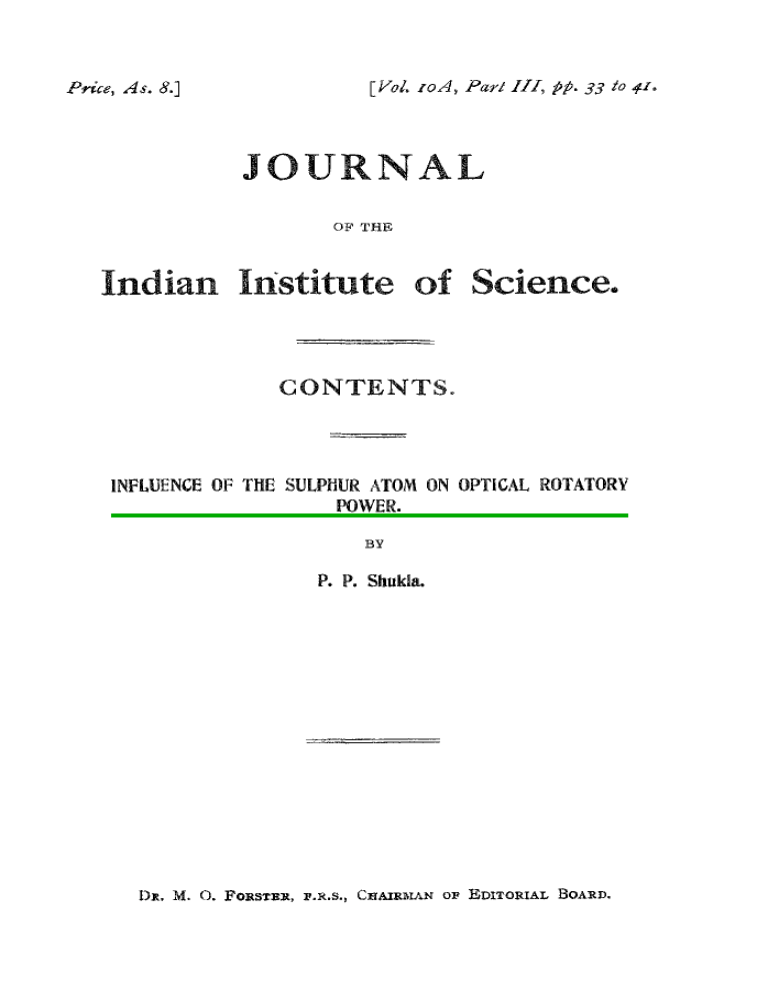
Pvice, As. 8.1 O F THE INFLUENCE OF THE SULPHUR ATOM ON OPTICAL ROTATORY POWER. INFLUENCE OF THE SULPHUR ATOM ON OPTllGAE ROTATORY POWER. BY P. P. Shukla. Apart from compounds owing their optical activity to an asymmetric sulphur atom, there are those in which the activity due to asymmetric carbon is influenced by a sulphur atom comprised in their constitution. Mercaptanyl and sulphonyl derivatives of some active compounds are instances of this latter class, along with cystine and its derivatives. Among such compounds the estimation of this influence has not been made, and the present paper describes attempts to achieve this purpose. Aryl derivatives of imino and bisiminocamphor were found by Forster, B. K. Singh and their collaborators to possess very high rotatory power (J.C.S., 1909, 95, 942 ; 1919, 115, 586 and 889, 980 and 1599 ; 1921, 119, 789 and 1971). T h e thio-derivatives of this class should therefore be convenient for the purpose indicated above, as it might be expected that considerable differences in rotation would be observable, and that some definite effect might be traceable to the sulphur atom. Hilditch (J.C.S., 1908, 93, 1618) has studied the influence of bi-, quadri and hexavalent sulphur on optical rotation. His work differs from the present inquiry, however, because he examined the rotatory power possessed by various sulphuryl derivatives of an optically active substance and then compared the effect produced by the sulphur atom in its different valencies ; whereas my purpose has been to investigate the rotatory power of some thio-imino-compounds in all of which the sulphur is bivalent. On comparing this with the rotatory power of similar derivatives not containing sulphur, it was invariably found that the sulphur atom had a depressing effect on the rotatory power, but the depression varied considerably in magnitude, as illustrated by the following examples : 1 Colupound $$'-Diphenylenebisiminocamphor ... ... LM] in chloroform ) .../ 5472' or 543%' 1 Depression This depression may be caused by breakillg the series of conjugated linkages, these being essential for producing that exaltation of rotatory power which reaches the maximum in I : 4-naphthylenebisi13~416' (Singh and Singh, J.C.S., 1920, minocamphor with [MI,, 117, 1599). On the other hand, the sulphur atom being associated with unsaturated valency, this might have had an exaltatory influence on rotatory power. The worl: of Hilditch made this a reasonable expectation. He found that a bivalent sulphur atom has a great influence on rotation, and states that most remarkable effect of all is the change observed when two bivalentsulphur atoms are conjugated, as seen from the following examples :I-Amy1 alcohol, C,H,, O H [MID - Di-Gamy1 sulphide, (C,H,),S ,, 4 Di-kamyl disulphide, (C,H,,),S, ,, + 149.40. 4.~8~. 42'67. Thus in the case of the iminocamphors, the depression produced by breaking the continuity of conjugated linkages is not outweighed by any exaltation due to a sulphur atom rich in residual affinity. This explanation of the depression observed ou bringing sulphur into the active camphor molecule could be tested in a simple manner. If the introduction of sulphur does not involve a breakage in the continuity of conjugated linkages the optical effect should be enhanced. preserves the continuity Thus, fib'-thiodiphenylaminebisiminocamphor, of conjugated linkages, and comparison with the unthiona ted con~pound prepared by B. K. Singh, M. Singh and J. La1 U.C.S., rgzI, 119, 1971) should establish the above point. Unfortunately, however, all attempts to prepare this compound failed. In spite of repeated efforts, $@.diaminothiodiphenylamine could not be condensed with camphorquinone. This fairure is not a solitary example. ppl-Dithiotoluidine is another compound which did not undergo condensation even on heating it with camphorquinone at about zooo. Nevertheless, trom all these attempts at condensation, successful or otherwise, some facts which seem to deserve record have emerged. Firstly, the presence of anhydrous sodium sulphate is found to facilitate condensation in all cases. Thus &pl-thiotduidine and camphorquinone do not 35 appear to react when an alcoholic solution is refluxed during 1 2 hours, but in presence of anhydrous sodium sulphate condensation is complete in seven hours. Secondly, the readiness with which various diamines undergo condensation appears to diminish in proceeding from the unthionated amine to the monothionated, and thence to the dithionated. Thus benzidine and camphorquinone are condensed when refluxed for six hours in alcoholic solution (Forster and Spinner, J.C.S:, 1919, 115, 889) whilst thioaniline requires seven hours' refluxing w ~ t hanhydrous sodium sulphate, and ppl-dithioaniline requires 24 hours. Similarly, tolidine hydrochloride and sodium acetate give the condensation product during four hours on a waterbath (Singh, Singh and Lai, J.C.S., 1921, 119, 1971) whilst thiop-toluidine requires not less than seven hours' refluxing in alcoholic solution with anhydrous sodium sulphate ; dithio-p-toluidine in similiar conditions does not react during one hundred hours. Preparation of the thio-bases required for condensation with camphorquinone presented unexpected difficulties. Although such bases, e.g., thioaniline have been known for many years, the experimental details controlling their preparation are often omitted, or stated in a manner which renders but scanty assistance to subsequent workers. Thioaniline was first obtained by Merz and Weith (Ber 1871, 4, 364) by heating aniline and sulphur together a t 170-I~o", hydrogen sulphide being liberated and a large proportion of ill-defined, resinous material produced ; they found that adding litharge reduced the reaction-temperature to between 150' and 160". O n repeating these experiments it was found that extracting thioaniline from the dark green, resinous melt presented much difficulty. Merz and Weith first removed the unchanged aniline and then precipitated fractionally the hydrochloric acid extract ; this procedure was followed, but the preponderating amount of sticky material precipitated along with a small quantity of thioaniline could not be avoided, and the crude thioaniline soon became green by oxidation. I t was finally purified by dissolving in ether-alcohol, carefully adding dilute sulphuric acid and neutralizing the precipitated sulphate with caustic soda. About one gram of purified thioaniline resulted from 50 grams of aniline, and it is noteworthy that Merz and Weith did not state their yield. I t seemed possible that a catalyst might control the reaction in one direction only ; but whilst iodine is the most successful of all catalysts employed in preparing thiodiphenylamine from diphenylamine and .sulphur, its application in the present case was not fruitful. Thus, although i t reduced the reaction-temperature to rqo",as indicated by 2 liberation of hydrog-en sulphide at that temperature, it did [lot preT,ent the formation of much resinous by-product. entirely different procedure for obtaining thioaniliue was llext investigated. @.&loronitrobenzene in action with sodium o r sulphide g&s dinitrodiphenyl sulphide, and this o n reduction should yield thloaniline. The process is not new, 1:or is i t So simple as might appear ; it has been studied by several workers who find, that along with dinitrodiphenyl disulphide there are produce4 to the conditions of the experiment the iollowing conlpounds :-pnitrothiophenol (m.p. 77') : 4 : 4':@-dichloroazoxybenzelle (n1.p. r 55O) : 4-nitro-4'-aminopher;y 1 s u l p h ~ d e(n1.p- 143') p-nitrophenyl sulphoxide (m.p. i 19") : 4 : 4'-dinitrodiphenyl disulphide (rn.p. 180.5") and the p-nitrophenyl ether of p-azophenyln~ercaptan (m.p. 164'). Experiments were therefore made to determine the conditions most suitable for the preparation of dinitrodiphenyl disulphide by this process, when it soon appeared that the procedure of Nietzki and Bothof (Ber., 1894, 27, 3261) is the most promising. A concentrated aqueous solution of sodium sulphide is poured irlto an alcoholic solution of p-chloronitrobenzene, and the mixture refluxed on a waterbath during seven hours. T h e results indicate, firstly, that with molecular proportions only one-half the @-chloronitrobenzene reacts, t h e remainder being recovered unchanged ; nevertheless, diminishing the proportion of sodium sulphide still further reduces the yield. Secondly, that commercial sodiunl sulphide containing a considerable amount of hydrosulphide, generates p-nitrophenyl mercaptan which is oxidised in air to ppl-dinitrodiphenyl disulphide. Kehnnann and Bauer's procedure (Bcr., 1896, 29, 2364) o n the other hand eliminates the effect of heat. Results by this method indicate that the yield of mixed dichloroazoxybenzene, dinitrodiphenyl sulphide and p-nitro-pt-aminodiphenylsulphide decreases, while that of dinitrodiphenyl disulphide increases with an increasing proportion of sodium sulphide, so that using a large excess, nearly six molecular proportions, only the disulphide is produced. When sodium sulphide is replaced by the hydrosulphide the principal product is dinitrodiphenyt disulphide again, as might be expected. A still simpler reaction would be that of finely powdered &chloronitrobenzenewith alkali sulphide in aqueous solution. With potassium s u l ~ h i d the e action starts slowly and appears to be controllable, but after shaking the cold mixture during half-an-hour considerable heat;--- -" was liberated suddenly, and the solution became red. After hrthershaking for three hours and remaining overnight, p-chloronitrobenzene was filtered and the aqueous solution acidified, when a pale yellow solid was precipitated. T h i s crystallised from much alcohol in large, thin, magnificent needles, sometimes three inches in length ; i t is the p-nitrophenyl ether of p-azophenylmercaptan, m.p. 164". Dinitrodiphenyl sulphide is reduced with zinc dust and acetic acid, excess of metal being dissolved in hydrochloric acid and the product treated with excess of caustic soda. When ether is used to extract thioaniline an'emulsion is formed and is difficult to break ; chloroforn~ was therefore substituted. Evaporation of the solvent leaves a dirty green solid crystallisable from dilute alcohol, which deposits slender needles, m.p. 105'. Thioaniline thus obtained is condensed with two molecular proportions of camphorquinone by heating in alcoholic solution with anhydrous sodium sulphate. T h e purified product crystallisesfrom benzene in spherical aggregates of small needles, m.p. 215' (Found : S, 6-32. C,H,,O,N,S requires S, 6-2j per cent.). A solution of 0-1320 gram in 2j C.C. of chloroform gave a, j%O, whence [a], 947' and [MI, 4848'. DehydrothiotoZuia'ine nnd PrirnwZzne. , These twocompounds were first prepared by A. G. Green (J.C.S., 1889, 55, 228) by heating together a t 175'p-toluidine (2 mols.) and sulphur (4 atoms) ; a modification due to Fierz-David was followed in preparing the compounds. After removing unchanged fitoluidine the melt was extracted with alcohol (93 per cent.), in which the crude dehydrothiotoluidine dissolves. It was purified by a lengthy process of crystallisation, first from ordinary alcohol and then from amyl alcohol, and crystallised from the latter in minute, faint yellow needles. m.p. 192'. T h e residue consists largely of primuline, and although this is stated to be insoluble in almost a11 organic media, extraction with these is not a satisfactory method for isolating the compouud, which was first freed from some associated deh~.drothiotoluidine with boiling, dilute hydrochloric acid : this left primuline as a pale brown, amorphous powder, melting above 27s0, soluble in pyridine, westron, aniline and nitrobenzene, but not crystallising from any of these. Qehydrothiotoluidine condenses with camphorquinoi~e when molecular proportions are heated in alcohol during 1a hours, brit :he action occurs more readily in amyl alcohol. T h e product crystallises from benzene in small, ill-defined aggregates, n1.p. 1 8 2 ~(Found : S, 8.33. C,IH,ON,S, requires S,8-25 per cent.) A solution, of 0-1164 gram in 2 5 c.c of chloroform gave a, 2 . 6 3 O , whence [a] 564.s0 and [MI, 2756'. When heated with camphorquinone in ppridine solution, primuline does not appear to undergo condensation. , plepared by Merz and Weith (LUG. This coinpound was o~~ginally cit.) but after some preliminary experiments I plepared it by reducing dinitrodiphenyl disulphide obtained according to the slightly modified PY. Chcm., 1902, 66 [a], 551). This gave procedure of Wohlfahrt (1. a 50 per cent. yield of dinitrodiphenyl disulphide, which was purified by repeated crystallisation from motor-benzol and melted at r8z0. Blanksma (Rcc. Trav. Ch.int.,1900, 19, . I I I ) gives the m.p. I 70°, unchanged by lecrystallisation, although when prepared from p-nitrophenyl mercaptan it melts at 180°, as recorded by Willgerodt, Bamberger and Kraus, Kehrmann and Bauer. In these experiments, also with alcohol, 1 have repeatedly obtained the compound with higher n ~ p . ,together with p$'-dinitrodiphenyl sulphide and p-nitro-$'aminophenyl sulphide. Blanksma states that the crystals explode to a fine powder at 134O, but 5 found the substance to melt at 182"without previous explosion, although, as the temperature falls, it solidifies at 145' and finally explodes at looo. pr. Chene., i890, 4t [ z ] , 199) states that when $$ILeuckart (1. dinitrodiphenyl disulphide is reduced with zinc dust and acetic acid, p-nitro-thiophenol is formed, whilst zinc and sulphuric acid give ##Idiaminodiphenyl disulphide. These results were not confirmed, dinitrodiphenyl disulphide being repeatedly recovered unchanged from such attempts at reduction. The ppl-diaminodiphenyl disulphide was finally obtained, however, by dissolving the dinitro-compound in boiling glacial acetic acid and carefully adding the calculated amount of freshly prepared stannous chloride solution. Dithioaniline thus obtained crystallised from dilute alcohol in slender, )ellow needles, m.p. 85". @~r-Dithiod~~he~z~~lene6isiwi~tocana~Aa~, C:N.C,H,.S.S.C,H,.N:C c,HH( 1 C:O ' o:& ~ 8 ~ 1 4 Dithioaniline (4 g.) and camphorquinone (7 g.) were dissolved in 25 C.C. of 99 per cent. alcohol and refluxed during 1 2 hours, the product being washed twice with boiling alcohol and crystallised from benzene in which i t is freely suluble. Small aggregates of )ellow needles were deposited, and these became orange a t 160°, red at 19g0, softening at zoo0 and melting at 201-2ozo (Found : S , I 1.54. C,,H,O,N,S, requires S, 11.76 per cent.). A solution of 0*0732 gram in 25 C.C. of chloroform gave a, 2.4', whence [a],, 820° and [MI , 4460". pp'-Thiotolz~itidz~ze and ppl-Bithiotoduidi9~e. &Y-Thiotoluidine was first obtained by Merz and Weith (Zoc. cit.) employing a method resembling that used £01 thioaniline ; to free the substance from resinous by-products a long and tedious process has to be pursued, and consequently the yields are bad. Their method was therefore modified with the fo~tunateresult that ppV-thiotoluidinewas obtained in good yield with only a small quantity of ppl-dithiotoluidine 3s by-product and no resin. @-Toluidine(107 g.), sulphur ( 3 2 g. of powder, not flowers) and anhydrous sodium carbonate (9.5 g.) were mtimately mixed, and heated in a round bottom flask surrounded by oil a t 140°. On adding a pinch of litharge no change occurred at once, but after a short interval at that temperature gentle frothing was noticed and became brisk. tithargc (I 1 2 g.) was then added in amounts sufficient to maintain frothing during about an hour and a half, the temperature being controlled to that mentioned. When most of the litharge had been added the frothing diminished, and ceased when all was entered. T h e cold melt was a dark green, viscous resin, and was extracted with 600 C.C. of 94 per cent. boiling alcohol. T h e extract was filtered hot, freed from alcohol by distillation, then rendered a l k a l i ~ ewith caustic soda (5 C.C. of ro per cent.) and steamed, yielding about 50 grams of ptoluidine. T h e black, oily residue in the distillation-flask solidified on cooling, and was extracted with 300 C.C. of hot, dilute hydrochloric acid ( r : q), the hot-filtered extract being evaporated on the water-bath. T h e first crop (thin yellow needles, 30g.) of hydrochloride gave almost pure p-th.iotoluidine, m.p. log0 when basified with ammonia ; yield, 15 grams. T h e acid extract on further concentration gave a second crop (brownish yellow crystals, 10 g.) which was dissolved in warm water and reprecipitated with hydrochloric acid ; the thin, yellow needles (7 g.) when basified with ammonia gave a yellowish base (3-5g.) meltIng at 74". As the high-melting base (103") dissolved in ether-alcohol does llot give a pecipitate with dilute sulphuric acid, the low melting base was dissolved in ether-alcohol and treated with dilute sulphuric acid until precipitation ceased. The precipitate was filtered, washed with ether-alcohol and recrystallised from hot water, which deposited thin, white needles. The base liberated from this product by ammonia crystallised from dilute alcohol in small, pale green needles, 111.p. 8go (Found: S, 22.19, CI4HL6S2 requires S , 23.19 per cent.). It was thus identical with the dithiotoluidine synthesised by. Jacobsen and Ney (Ber., 1889, 27, 908) and shown to have the constitution. The otherbase crystallised fromdilute alcohol in slender, yellowishgreen needles, m.p. roq0, and has been identified as kdiaminotolyl sulphide (3) or di(6-amino-3-meth~lphenyl)sulphide. I t appears to have been erroneously stated by Purgotti (Gazdta, 1890, 20, 52) as ~;ivinga-ditolyl sulphide with nitrous acid in alcohol. T h i s probably arose from the fact that the boiling-points of o- and vz-ditolyl sulphides are approximate, while at that time vn-ditolyl sulphide not been made. o-Ditolyl sulphide, which Purgotti stated to boil at 284-286O, was later (Bey., 1895, 28, 1674; 1906, 39, 3595) shown to have m.p. 64" and b. p. 175" (16 mm.). m-Toly! sulphide appears to have the same b. p., 174'. under 1 2 mm. pressure (Bey., 1go6,39, 3595). W h e n the above base (m.p.104" was treated with ethyl nitrite in alcohol there was produced a yellowish oil boiling at 175O (15 mm.) and remaining liquid after many days in the ice-chest ; I therefore believe this to be m-tolyl sulphide. Thio-fitoluidine ( 2 g.) and camphorquinone (3'3 g.) dissolved in go per cent. alcohol were refluxed with anhydrous sodium sulphate during seven hours, it having been found that without the salt condensation does not take place in I 2 hours. On evaporating the filtered solution, yellowish crystals separated and were recrystallised from motor-benzol in small, indefinite orange groups, m.p. 21B(Found : S, 5-90. C,H,O,N,S requires S, 5.90 per cent.). A solution of 0.1360 gram in 25 C.C. of chloroform gave a, 2 q 0 , whence [0] 407.6~ and [MI, , 2201~. Dithio-ptoluidine (2.5 g.) and camphorquinone (3.5 g.) were similarly treated during ~ o hours, o and from the resinous mass left on evaporating alcohol the camphorquinone was removed by steam. O n rubbing this residue with petroleum (b.p. 60-80") there remained a small quantity of dark brown powder melting at 216~. T h i s product was also obtained by heating dithiotoluidine sulphate (1.5 g.) intimately mixed with camphorquinone (r.5 g.) and anhydrous sodium acetate (3 g.) in a long test-tube fitted with a condenser and surrounded by oil at 200° ; the dark sticky mass remaining after treating the cold melt with water was washed with alcohol and petroleum, when the dark brown powder was left. This is not the condensation product as it does not give camphorquinone with boiling dilute or concentrated hydrochloric acid; moreover, it is not produced from the base alone when this is exposed to the temperature stated. Indian. Izstttecte of Science, [Accepted, 4-3-27.]

